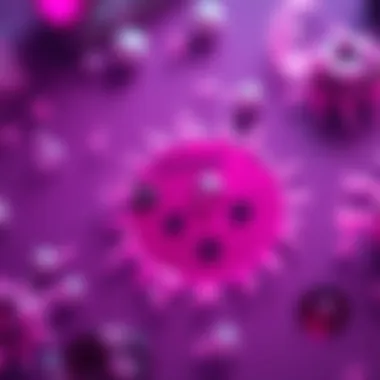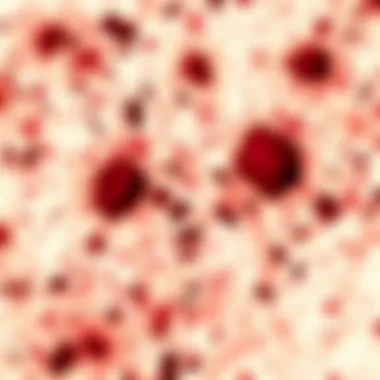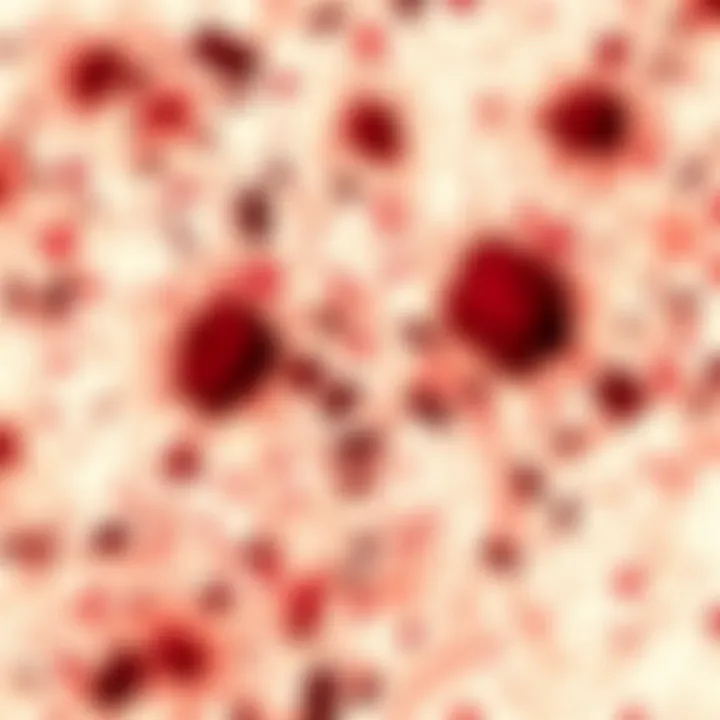Exploring Gram Stain Classification of C. difficile


Overview of Research Topic
Brief Background and Context
Clostridium difficile, known for its role in antibiotic-associated diarrhea, poses significant challenges in healthcare settings. This bacterium is classified as gram-positive, which reflects its ability to retain the crystal violet stain used in the gram staining process. Understanding its classification goes beyond the simple observation of color; it reveals insights into its cellular structure and pathogenicity.
C. difficile infections (CDI) often occur following antibiotic treatment, disrupting the gut flora balance. This disruption creates an opportunity for C. difficile to proliferate, leading to symptoms ranging from diarrhea to more severe colitis. The gram stain classification provides foundational knowledge critical for clinicians in diagnosing and treating infections effectively.
Importance in Current Scientific Landscape
In today's world, C. difficile remains a prime target for research due to rising incidence rates and increasing resistance to treatment options. Knowledge of its classification not only aids in clinical diagnosis but also informs treatment strategies, making it a crucial topic for microbiologists, healthcare providers, and infection control specialists.
The importance of understanding species like C. difficile within the broader context of gram-positive bacteria cannot be overstated. As healthcare facilities continuously strive to prevent hospital-acquired infections, grasping the nuances of gram stain classification assists in implementing effective infection control measures.
"Grounding clinical understanding in microbiological principles is vital for combating infections like C. difficile, which only gain ground as antibiotic use changes."
Methodology
Research Design and Approach
This article employs a qualitative approach to explore the intricacies of Clostridium difficile classification through the lens of gram staining. A thorough literature review was conducted, focusing on peer-reviewed articles, clinical studies, and microbiological research. This investigation seeks to bridge the gap between fundamental microbiological classification and its real-world clinical implications.
Data Collection Techniques
Data for this exploration was retrieved from various academic databases such as PubMed, JSTOR, and Google Scholar. Sources were meticulously scrutinized for relevance and credibility to ensure the information presented is not only accurate but also contemporary. This methodology affirms that insights derived from this article are built upon a solid foundation of reputable research, providing an informed outlook on the topic.
Intro to Clostridium difficile
Clostridium difficile, often referred to simply as C. difficile or C. diff, is a significant player in the world of microbiology and clinical medicine. Understanding its classification, particularly through the lens of the Gram stain, is vital not just for academia, but also for practical healthcare applications. This bacterium has made headlines for its role in hospital-acquired infections, and its increasing prevalence highlights the need for clarity on its characteristics and behavior.
The Gram stain classification is a critical component of microbiological studies. It categorizes bacteria based on their cell wall structure, which directly affects their interactions with antibiotics and the immune system. C. difficile is classified as a Gram-positive bacterium, a status that carries implications for its treatment and management.
In this article, we delve deeper into the characteristics, significance, and challenges associated with C. difficile. We will explore its historical background, the essential microbiological concepts surrounding its classification, and its clinical relevance. This multifaceted approach aims to enrich the understanding of C. difficile, providing valuable insights for students, researchers, educators, and professionals alike.
Historical Overview
C. difficile was first identified in 1935, but its importance wasn't recognized until the 1970s when it was linked to antibiotic-associated diarrhea. The bacterium possesses distinct characteristics, including the ability to produce toxins that can lead to severe intestinal disease.
Historically, the understanding of C. difficile in medical circles has evolved as researchers uncovered its complex lifecycle and mechanisms of pathogenicity. The rise in antibiotic use in healthcare settings has made this bacterium more prominent, and as a result, efforts in infection control and treatment protocols have had to adapt. This evolving narrative showcases how history shapes the ongoing battle against infections caused by C. difficile.
Importance in Microbiology
In the realm of microbiology, C. difficile serves as a model organism for studying Gram-positive bacteria. Understanding its cell wall structure, which is rich in peptidoglycan, offers insights into antibiotic resistance mechanisms, a growing concern in modern medicine. Moreover, C. difficile stands out for how it responds to antibiotics, living in a world where many have become resistant.
The study of C. difficile also highlights broader trends in microbiology, such as the impact of environmental factors, the role of gut flora in human health, and the significance of infection control practices in healthcare facilities. By focusing on C. difficile, we peer into a microcosm of pressing issues that microbiologists and healthcare professionals face today. It emphasizes the need for continued research and innovation to tackle antibiotic resistance, improve treatment options, and enhance patient care.
Understanding Clostridium difficile's characteristics is crucial not just for effective treatment but also for safeguarding public health.
With this background, we set the stage to further investigate the Gram stain process, mechanisms of staining, and the implications of C. difficile's Gram-positive status for clinical practice.
The Gram Stain Process
The Gram stain process is a pivotal technique in microbiology that serves to distinguish two broad categories of bacteria: gram-positive and gram-negative. For Clostridium difficile, this staining method is particularly valuable as it aids in quick identification and further informs treatment decisions. Its significance extends beyond mere categorization; understanding the Gram stain process paves the way for unraveling the characteristics and behaviors of this bacterium in a clinical setting.
Overview of Gram Staining
Gram staining is a laboratory technique that involves a series of steps to color bacterial cells based on their characteristics, particularly their cell wall structure. This process involves four main steps: application of crystal violet dye, iodine treatment, decolorization, and saffron counterstaining. Each step is necessary to ensure the correct classification of bacteria.
The primary purpose of gram staining lies in its ability to help clinicians and researchers quickly determine the type of bacterial infection a patient may have. For instance, the gram-positive nature of C. difficile results in it retaining the crystal violet dye, leading to a purple appearance under a microscope, which serves as a clear visual cue for identification. Moreover, this method also allows health professionals to make informed decisions regarding the appropriate antibiotics to use in treatment, since gram-positive bacteria often respond differently compared to their gram-negative counterparts.


Mechanisms of Staining
The mechanisms underlying the Gram staining method are critical for understanding how this process differentiates between bacterial types. Each step in the staining process contributes to the overall outcome of the classification.
Crystal Violet Application
Crystal violet is the primary dye applied during the initial step of gram staining. Its role is fundamental; the dye penetrates the bacterial cell walls and alters their coloration. This dye is favored because of its widespread ability to interact with a variety of bacterial strains effectively. What sets crystal violet apart is its strong affinity for the peptidoglycan layer found in the cell walls of gram-positive bacteria. This characteristic makes it a popular choice in the Gram stain process, as it ensures that any gram-positive organisms retain the purple hue.
However, it's not without its drawbacks, as not all bacteria react to it uniformly. Some strains may not take up the dye as expected, complicating the interpretation of results.
Iodine Treatment
The iodine treatment step follows the application of crystal violet and serves as a mordant. Iodine binds to the crystal violet dye, creating a complex that enhances retention of the dye within the bacterial cell wall. This step is crucial as it reinforces the color of gram-positive bacteria. Noteworthy is the iodine's effectiveness in ensuring that the purple color persists during subsequent steps of the process.
However, it's important to recognize that if this step is improperly executed, the resulting complexes may not form effectively, leading to misclassification of the bacterial type.
Decolorization Step
The decolorization step is where things get interesting. This is often deemed the most critical part of the staining process and involves the use of alcohol or acetone, which disrupts the cell membrane. For gram-positive bacteria like C. difficile, the thick peptidoglycan layer retains the violet dye, but the decolorization seeks to wash it out of gram-negative bacteria. This is a double-edged sword; if the solution is left on too long or not long enough, it could lead to false results, misidentifying the bacteria present.
Saffron Counterstain
Finally, the saffron counterstain provides contrast and allows visualization of gram-negative bacteria that might not retain the purple dye. Saffron works well because it’s lighter and provides a clear reddish hue against the darker purple backdrop of gram-positive cells. Its incorporation is essential for distinguishing various types of bacteria, ensuring that clinicians have comprehensive information regarding a sample.
Ultimately, while saffron counterstaining is a beneficial step, it carries the risk of masking results if contamination occurs or if the staining procedure isn't followed meticulously.
The Gram stain process, particularly the methods applied, facilitates not just the identification of C. difficile but also strategic clinical decisions, influencing treatment and improving patient outcomes.
C. difficile: A Gram-Positive Bacterium
Understanding Clostridium difficile, or C. difficile, as a gram-positive bacterium is paramount when delving into its behavior, clinical implications, and treatment strategies. This classification signals not just its structural characteristics but also points to its response to various environmental challenges, particularly antibiotics. The significance of identifying C. difficile as gram-positive cannot be overstated; it influences how healthcare professionals approach infection control, treatment protocols, and even diagnosis.
Gram-positive bacteria are generally characterized by their thick peptidoglycan cell wall, which can retain crystal violet dye during the gram staining process. This durability often results in higher resistance to certain types of antibiotics, a crucial consideration in clinical settings.
Cell Wall Composition
Peptidoglycan Structure
The peptidoglycan structure in C. difficile comprises a multi-layered meshwork, which provides the bacterium with shape and structural integrity. This unique characteristic is significant; it not only supports the cell but also serves as a formidable barrier against environmental threats.
- Key Characteristic: The thickness of the peptidoglycan layer allows C. difficile to resist osmotic pressure and survive in harsh conditions that might typically compromise other bacteria.
- Benefits for Understanding: In articles like this one, highlighting the peptidoglycan structure helps clarify why certain antibiotics, like penicillin, may be less effective against C. difficile. This bacterium's robust cell wall can act as a shield, minimizing the impact of treatments aimed at disrupting bacterial cell walls.
- Unique Feature: Unlike some other gram-positive bacteria that may have fewer layers of peptidoglycan, C. difficile’s architecture is highly adaptable, which also plays a role in its pathogenicity.
Teichoic Acids
Teichoic acids are another crucial feature distinguishing C. difficile's cell wall composition. These polymeric substances contribute significantly to the structure and functionality of the bacterial cell wall.
- Key Characteristic: Found embedded within the peptidoglycan layer, teichoic acids provide cell wall elasticity and are pivotal in maintaining the integrity of the bacterial structure.
- Benefits for Understanding: Their presence offers insights into the bacterium's ability to anchor itself to host cells and resist phagocytosis. This is valuable when discussing the virulence factors of C. difficile in clinical contexts.
- Unique Feature: One distinguishing characteristic is that teichoic acids can interact with host immune systems, which may lead to evasion strategies that complicate treatment. Understanding their role can elucidate why certain infections are more difficult to combat.
Implications of Gram-Positive Status
Susceptibility to Antibiotics
The susceptibility of gram-positive bacteria, including C. difficile, to antibiotics is a double-edged sword. On one hand, certain antibiotics targeting peptidoglycan synthesis can effectively combat these organisms. On the other hand, the resistant traits of C. difficile complicate treatment measures.
- Key Aspects: Knowing the specific antibiotics that are ineffective against C. difficile helps in formulating treatment strategies. This bacterium is known for its ability to resist common options, such as beta-lactams, due to its robust cell wall composition.
- Unique Feature: This resistance often leads clinicians to reconsider their antibiotic choices, stressing the importance of tailored approaches in the management of infections caused by C. difficile.
Resistance Mechanisms
Resistance mechanisms in gram-positive bacteria like C. difficile are intricate and often multifaceted. This aspect plays an essential role in understanding how these bacteria survive amid aggressive treatments.


- Key Aspects: Resistance mechanisms include the production of enzymes that break down antibiotics or modifications of target sites that reduce the efficacy of these drugs.
- Unique Feature: The phenotypic variability of C. difficile can lead to the emergence of new strains that adapt to the antibiotic pressures applied in clinical settings, challenging existing therapeutic models.
Understanding the attributes of C. difficile as a gram-positive organism is critical to tackling its growing prevalence in clinical contexts.
Clinical Significance of C. difficile Infections
Clostridium difficile, often simply referred to as C. difficile, stands out on the microbiological landscape chiefly due to its association with significant health risks. Understanding its clinical significance is of utmost importance, especially given the context of rising incidence rates and the implications for patient management. C. difficile infections (CDIs) are not just another health issue; they embody a complex intersection of antibiotic stewardship, healthcare practices, and patient vulnerability.
Symptoms and Diagnosis
Overview of Symptoms
A hallmark of C. difficile infection is the spectrum of symptoms it presents, which can vary largely between individuals. Key characteristics include severe diarrhea, abdominal pain, and sometimes fever. The distinctive feature of symptoms such as watery stools can push the diagnosis towards C. difficile as it often arises after antibiotic treatment, indicating a possible dysbiosis of gut flora.
The significance of recognizing these symptoms can’t be overstated. Timely identification allows for targeted treatment, which is crucial for improving patient outcomes. While the symptoms might seem banal at first glance, it becomes evident that every detail — from the frequency of diarrhea to the presence of abdominal cramping — can provide clues vital for diagnosing infection.
Diagnostic Techniques
When it comes to confirming a C. difficile infection, several diagnostic techniques come into play. The most commonly used methods include enzyme immunoassays for toxins A and B and nucleic acid amplification tests (NAATs) such as PCR. The latter has gained traction due to its high sensitivity and specificity, making it a frontrunner in clinical laboratories.
The reliance on these diagnostic techniques underscores their importance in clinical settings. The capability to quickly ascertain the presence of C. difficile not only allows for appropriate antibiotic therapy but also plays a pivotal role in infection control within healthcare facilities. However, challenges remain, such as the risk of false-positive results with NAATs or the need for concurrent clinical correlation with the symptoms manifesting.
Treatment Approaches
Antibiotic Options
In tackling C. difficile infections, healthcare providers lean heavily on specific antibiotics. Vancomycin and metronidazole are among the most frequently employed, and their selection is based on factors like severity of the infection and patient medical history. The choice of antibiotic serves as a double-edged sword; while these medications target the C. difficile bacteria effectively, they also carry risks such as potential recurrence of infection once the treatment concludes.
The efficacy of antibiotic options relies not only on their ability to eradicate the bacteria but also on their impact on the patient's microbial balance. Previous usage of broad-spectrum antibiotics often predisposes patients to CDI, creating a situation where an irony unfolds — antibiotics that could save lives sometimes pave the way for more stringent infections.
Probiotics and Fecal Transplant
Increasingly, probiotics and fecal transplants have carved a significant niche in the approach to managing C. difficile. Probiotics, which introduce beneficial bacteria back into the gut, have shown promise in preventing recurrences. On the other hand, fecal microbiota transplant (FMT) is becoming a more accepted treatment option for recurrent cases, restoring an individual's gut microbiota to its pre-infection state.
What makes these strategies especially compelling is their deviation from traditional pharmacological approaches. While probiotics may offer a relatively low-risk adjunct therapy, the unique feature of fecal transplants stands out as a revolutionary method that directly re-establishes gut flora diversity. Even though these options exhibit various advantages, the considerations such as availability, costs, and patient acceptance remain significant in their application, thus fostering ongoing research into optimal treatment methodologies.
"Addressing C. difficile infections requires a multifaceted approach that encompasses accurate diagnostics, effective treatment options, and preventative measures to truly mitigate its clinical impact."
In sum, the clinical significance of C. difficile infections encapsulates an array of factors, including understanding symptomatology, the importance of precise diagnostic techniques, and the evolving treatment paradigm that can empower healthcare providers with tools to combat this formidable pathogen.
Preventing C. difficile Infections
Preventing infections caused by Clostridium difficile is not just a priority for healthcare professionals but also a crucial public health goal. The growing incidence of C. difficile infections (CDI) highlights the need for robust measures to stop their spread. This section examines effective methods to combat these infections, focusing on infection control measures and educational strategies.
Infection Control Measures
The cornerstone of preventing C. difficile infections is implementing strict infection control measures. These measures are essential for mitigating the risk of transmission, especially in healthcare settings where vulnerable populations are present.
Hand Hygiene Protocols
Hand hygiene protocols play a fundamental role in infection prevention. This aspect entails frequent hand washing with soap and water or using alcohol-based hand sanitizers. It is crucial because C. difficile spores can survive on hands even after using alcohol-based sanitizers; hence, hand washing remains the gold standard. A key characteristic of hand hygiene is its simplicity yet effectiveness. Healthcare professionals and patients need to be aware of proper hand hygiene to eliminate the spores effectively.
The unique feature of adopting hand hygiene protocols is the direct involvement of both healthcare staff and patients in maintaining cleanliness. While hand washing is favorable, the disadvantages include the challenge of compliance, particularly in busy healthcare environments, where multitasking might distract from hygiene practices.
Environmental Cleaning
Environmental cleaning complements hand hygiene and focuses on maintaining a clean healthcare environment. C. difficile spores can reside on surfaces for extended periods, making thorough cleaning essential. This practice includes the use of disinfectants specifically effective against spores. The primary characteristic of environmental cleaning is the systematic approach to decontaminating surfaces that come into contact with patients.
One unique aspect of effective environmental cleaning is the use of sporicidal agents to eliminate resilient spores. The advantage here is reduced infection risk in health facilities. However, environmental cleaning can be labor-intensive and may require additional staff training and resources. Cleaning efforts must be consistent and prioritised to ensure the safety of patients.


Educational Strategies
Beyond physical measures, educating healthcare professionals and patients is equally important in preventing CDI. Raising awareness about the infection, its transmission, and prevention strategies can make a significant difference.
Raising Awareness in Healthcare
Raising awareness in healthcare settings centers around ensuring that healthcare staff have up-to-date knowledge about C. difficile and its potential risks. Key characteristics of this approach include workshops, seminars, and continual training for practitioners, on the importance of infection control protocols and recognizing signs of CDI. This has proved beneficial as informed staff are more capable of implementing preventive measures.
The unique feature of this awareness strategy is its cascading effect. When healthcare professionals understand the risks, they can instruct patients and families accordingly. However, one downside may be the variability in engagement levels among staff, which can hinder the consistency of awareness efforts.
Patient Education
Patient education is vital to empower individuals to take charge of their own health. Providing information about C. difficile risks and prevention strategies enables patients to act knowledgeably when seeking care. Highlighting this aspect allows patients to understand the need for strict hygiene and the importance of reporting any symptoms promptly.
A distinct aspect of patient education is its accessibility through brochures, digital tools, and consultations. The advantage is that it encourages patients to be engaged partners in their healthcare. Yet, the challenge lies in ensuring that information is conveyed in a manner that patients can grasp easily, particularly for those with limited health literacy.
"Prevention is better than cure" - This old saying rings especially true in the fight against C. difficile infections, where proactive measures can save lives and resources.
Current Research and Future Directions
The field of C. difficile research has been evolving rapidly, considering the bacterium's significant impact on global health. This part of the article will delve into contemporary investigations and potential future pathways that could reshape our understanding of C. difficile infections. Studying this topic offers several benefits, including improving therapeutic options and shedding light on infection control strategies.
Developing New Therapeutics
The development of novel therapeutics against C. difficile is a crucial focus in scientific research. Traditional antibiotics often fail due to resistance issues and recurrence after treatment, necessitating the search for alternative strategies. Here are some noteworthy advancements in this area:
- Monoclonal Antibodies: Recent studies are exploring monoclonal antibodies designed to neutralize the toxins produced by C. difficile. Research indicates that these antibodies can significantly reduce the severity of infections and prevent relapses.
- Bacteriophage Therapy: Utilizing bacteriophages – viruses that target and destroy bacteria – is gaining momentum. This innovative approach not only targets C. difficile but can also tailor treatments based on the specific strains present in patients.
- Small Molecule Inhibitors: Investigations into small molecule inhibitors focus on disrupting the pathogenicity of C. difficile. By targeting key metabolic pathways in the bacteria, researchers aim to develop drugs that minimize harmful effects without promoting further resistance.
- Vaccines: Vaccine development is another front in combating C. difficile. Initial trials are underway to evaluate the safety and efficacy of various vaccine candidates that could potentially reduce the incidence of infections.
Each of these therapeutic avenues presents its own set of challenges, but the ongoing research holds promise for improved patient outcomes and could fundamentally alter treatment strategies.
Understanding Resistance Mechanisms
Comprehending the resistance mechanisms that allow C. difficile to withstand traditional antibiotic treatments is vital for advancing therapeutic alternatives. Research indicates that factors such as genetic adaptations and biofilm formation contribute to the resilience of this pathogen. Some important points in this area of study include:
- Gene Expression Studies: Ongoing investigations focus on how C. difficile expresses resistance genes under different conditions. Understanding these mechanisms allows scientists to pinpoint potential targets for new drugs.
- Biofilm Research: The formation of biofilms by C. difficile complicates treatment, as bacteria within biofilms can be up to a thousand times more resistant to antibiotics. Research aimed at disrupting biofilms could lead to innovative approaches in therapy.
- Cross-Resistance: Exploring cross-resistance—where bacteria develop resistance to multiple antibiotics—can provide insights into the pathways and genetic changes that contribute to persistent infections. This understanding is critical for developing new agents that can effectively circumvent these mechanisms.
As research progresses, insights into these resistance mechanisms could directly influence clinical practices, aiding in the development of more effective interventions for C. difficile infections.
"Understanding the mechanisms that underlie antibiotic resistance in Clostridium difficile is fundamental to developing new treatment options that can overcome these barriers."
In summary, current research in the realm of C. difficile is paving the way for innovative treatment modalities. From the development of new drugs to a deeper comprehension of resistance, these efforts are instrumental in enhancing our approach to one of healthcare's most pressing challenges.
For more information on C. difficile research, you can visit:
- National Institute of Health
- Centers for Disease Control and Prevention
- Nature Reviews Microbiology
- World Health Organization
Research surrounding C. difficile continues to evolve, presenting new avenues for clinicians, researchers, and microbiologists alike.
Closure
The conclusion serves as a capstone to the rich narrative surrounding the gram stain classification of Clostridium difficile. It is essential to synthesize the key points discussed throughout the article and underscore the importance of understanding this bacterium not just as a microbial entity, but as a significant player in the health landscape.
Integration of Findings
The integration of findings highlights how the classification of C. difficile as gram-positive influences various aspects of microbiology and clinical practice. This insight is not merely academic; it directly informs diagnosis and treatment strategies. Knowledge of its gram-positive cell wall structure provides crucial context for its behaviors in the presence of antibiotics. For instance, understanding its peptidoglycan thick layer assists healthcare professionals in anticipating resistance patterns. The importance of this understanding cannot be understated. In clinical scenarios, awareness of the delicate balance between treatment efficacy and bacterial adaptability can guide more effective therapeutic choices.
The Broader Implications for Healthcare
Looking beyond the immediate implications for treatment, the broader healthcare context emerges from our discussion. With C. difficile infections being a growing concern in healthcare settings, encompassing hospitals and extended care facilities, a comprehensive understanding becomes critical for infection control. Awareness of the gram-positive classification equips healthcare providers with the insight needed for better preventative measures, enhancing overall patient care.
In summary, the conclusions drawn from our examination of the gram stain classification of C. difficile underscore its relevance in both clinical microbiology and public health strategies. The challenges posed by this bacterium, coupled with the nuances of its classification, highlight an urgent need for continuous research and education in combating its impact on patient populations. Gaining an understanding of C. difficile’s characteristics enables healthcare professionals to act proactively, improving outcomes and reducing the burden of infection.
"Knowledge is like a lamp that helps in navigating the complex tapestry of healthcare."
Using resources from reliable sites like Wikipedia or Britannica can further deepen one's comprehension of this important topic.



